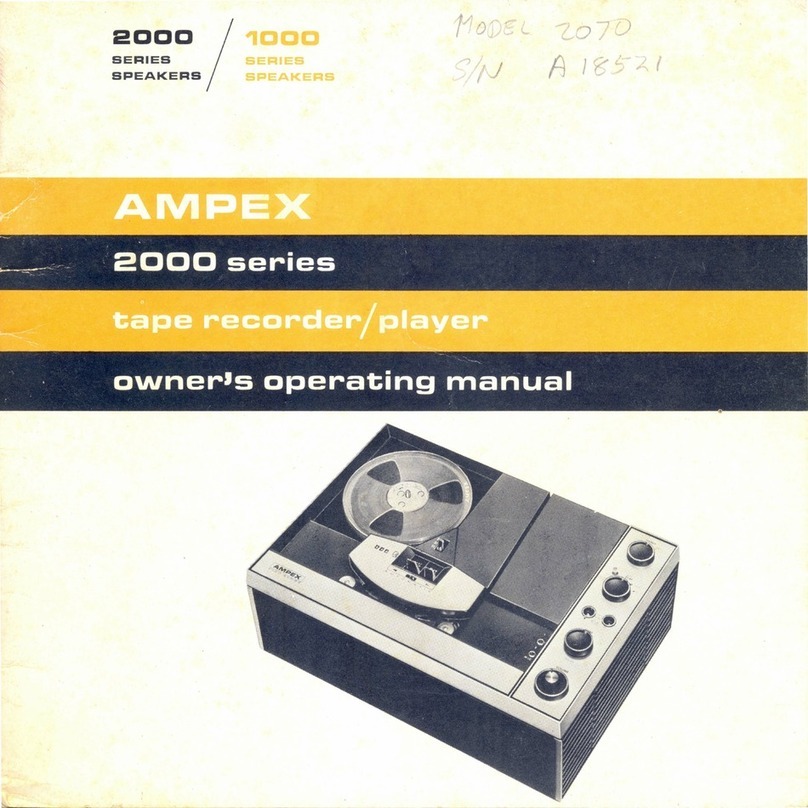
www.SteamPoweredRadio.Com
SPECIFICATIONS
1-2
Tape
Width
Reel Size
Tape Speed
Playing
Time
Reproduce
Timing
Acrnracy
Flntter and Wow
Starting
Tim
e
Stopping
Tim
e
Fast
Forward
Time
Rewind
Tim
e
Freq1f
ency Response
Si,?nal-10-Noise Ratio
R
eco
rd Inputs
Reproduce
Output
0 perating Contro/J
¼ inch.
7 inch,
RETMA
reel
(maximum).
7½ ips, tull track.
7½
ip
s, half track.
3¾ ip
s,
full rrack.
3¾ ips, half track.
Full
Tra
ck
-32
minutes with 7 inch reel,
7½ ips, 1
200
fee
r.
Half
Track-6/4
minutes wirh 7 inch reel,
7½ ips, I
200
feet.
±0.29?,
or
an accuracy
of
±}6
seconds
in
a 30-minute recording.
71/i
ips-Below 0.17% rms.
3¾
ips-Below 0.3% rms.
The
tape attains full speed
in
less than one-
fifth second
in
either the play
or
record mode.
less rhan one second.
90
seconds for full 1
200
foot reel.
90 seconds for full 1200 foor reel.
7½
ips-40
to 15,000 cps
±2
db
50 ru
10,000 cps down no more than 4
db
ar 15,000
cps.
3¾
ips
--±2
db
50 to 7500 cps.
Full
Tra
ck-ove
r
55
db
below peak r
ec-
ord level. Peak record level is defined
as
rhe
poinr
of
3ri: roral rms harmonic distortion
measured while using a
400
cps tone; and
peak record level includes bias, erase and re-
produce amplifier noise.
Half
Tr
ack-50
db
below peak record
lev
el.
MICROPHONE:
Accommodates any high
impedance microphone, and can be quickly
converted for a low
imp
edance microphone
with
rhe plug-in accessory transformer (Cat-
alog
No.
17331-1).
LJNE: 0.5 vole required for normal program
level.
l.23 voles rms into 600 ohms
at
program
level.
PLAY
-REC:
The
play mode is selected
by
placing rhe swirch in PLAY position.
Th
e record mode
ca
n be selected
only_
by de-
pre
ssing the safety button
at
the same rime
the selector switch is placed
in
REC
posirio
n.
Th
e safety button, a flat topped neon la
mp
,
remains
li
ghte
d while the machine is in the
record mode.
REWIND-FAST
FWD
:
This
selector
switch is mechanically
int
erlocked with the
PLAY-REC
switch.
Reproduce O1itput
Operating Controls
Miscellaneo:u
Monitoring
Head Assembly
Power Requirements
A
ccesso
ries
MIC REC LEVEL, and LINE REC LEVEL
SPEC
IFIC
AT
I
ONS
are separate mixing conrrols.
Th
e
MONITOR
SELECTOR switch is used
for monitoring
as
described in the following
paragraphs; but it functions also as an oper-
ating control. In the PLAY mode, rhe
MON-
ITOR selector switch must be in the
TAPE
position in order to bring the reproduce head
signal to the
OUTPUT.
A roggle
ON
-OFF switch, located on the
control panel, turns power on
or
off.
When
placed in rhe
ON
position, this toggle switch
will cause the capstan to rotate; bur the rape
will nor move unril one
of
the two operating
switches is mrned from its neutral position.
The
MI
CROPHO
NE
input, a t
hr
ee circuit
connector, is conve
ni
enrly located on rhe con-
trol panel.
The
PHONES
output
is
a two circuit jack,
located
on
th
e
fr
ont
panel.
The
LINE
INPUT
connector
is
a rwo
ci
rcuit
jack recessed into
tlhe
right side
of
the equip-
ment.
The
OUTPUT
connector is a three circuit
jack also recessed into the right side of the
equipment.
Mating connectors are supplied (see Table
1-1).
The
MONITOR
SELECTOR switch allows
monitoring
of
program input,
or
repr
oduce
output. A phone jack
and
illwninated v-u
meter are on the
front
panel.
When
the
TAPE
position is selected, the re-
produce
output
can be monitored.
Wh
en the INPU1[' position is selecred, the
headphones and merer report
pr
ogram signal
level.
Separate erase, record, and reproduce heads
are contained
in
a single housing.
117 volts, 50
or
60
cps; 0.52 ampere, 61
warts.
Maintenance
Kit
:
Speed Conversion Kits to:
3¾
ips,
60
cps
7½
ips,
60
cps
3¾
ips,
50
cps
71/i
ips,
50
cps
6392-1
7556-0
7556
-1
7556-2
7556-3
1-3




























